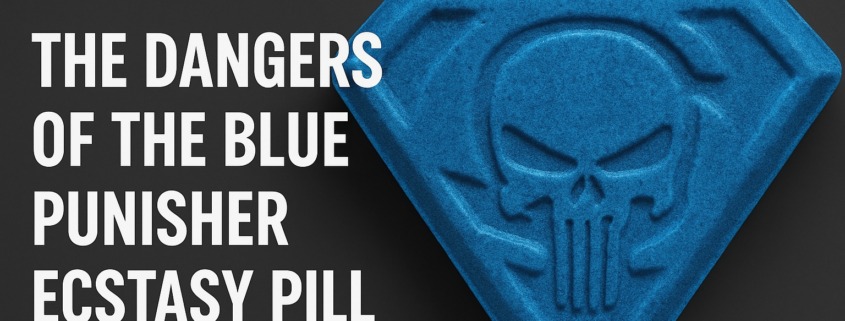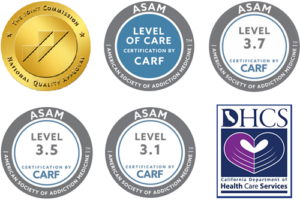What Is the Blue Punisher Ecstasy Pill?
Understanding the Dangers and Finding Help
Blue Punisher ecstasy pills have gained notoriety as one of the most dangerous MDMA pills circulating in the United States and internationally. These tablets, stamped with the recognizable Marvel Comics Punisher skull logo, contain extremely high doses of MDMA—often three to five times the amount found in typical ecstasy pills. Law enforcement agencies, health departments, and harm reduction organizations have issued repeated warnings about Blue Punisher pills due to their connection to numerous hospitalizations and fatalities.
If you or someone you know has used Blue Punisher pills or struggles with MDMA/ecstasy use, understanding the severe risks is essential. At Journey Hillside Tarzana, we provide comprehensive detox and residential treatment for individuals facing substance use challenges. Recovery is possible, and help is available.
What Are Blue Punisher Pills?
Blue Punisher pills are a specific type of ecstasy tablet that has appeared in drug markets across multiple countries since approximately 2016. These pills are typically:
- Blue in color (though color variations exist, including purple and pink)
- Stamped with the Punisher skull logo from Marvel Comics
- Exceptionally high in MDMA content, ranging from 250mg to over 300mg per pill
- Sometimes contaminated with other substances like methamphetamine, fentanyl, or synthetic cathinones
A typical ecstasy pill contains between 50-150mg of MDMA. Blue Punisher pills regularly contain two to three times this amount, making them particularly dangerous even for experienced users. The pills’ distinctive logo and reputation have paradoxically made them sought-after in some communities, despite—or sometimes because of—their extreme potency.
Health authorities in the United Kingdom, Australia, New Zealand, Canada, and several U.S. states have issued specific warnings about Blue Punisher pills. According to the National Institute on Drug Abuse, MDMA affects the brain’s neurotransmitter systems, and high doses significantly increase the risk of life-threatening complications.
Why Are Blue Punisher Pills So Dangerous?
The extreme danger of Blue Punisher pills stems from several factors that compound their risk:
Exceptionally High MDMA Content
The primary danger is the massive dose of MDMA in each pill. While recreational users might expect a dose of 80-120mg, Blue Punisher pills can deliver 250-300mg or more. This overwhelming amount can cause:
- Severe hyperthermia (dangerously elevated body temperature)
- Cardiovascular strain leading to heart attack or stroke
- Serotonin syndrome, a potentially fatal condition
- Seizures
- Acute kidney or liver failure
Unpredictable Composition
Not all Blue Punisher pills are created equal. Analysis by drug checking services has revealed that pills with the same logo can contain:
- Varying amounts of MDMA (from 200mg to over 300mg)
- Adulterants including methamphetamine, which increases cardiovascular risks
- Novel psychoactive substances with unknown safety profiles
- In some cases, dangerous contaminants like fentanyl
Misperception of Dosage
Many people who take ecstasy assume that “one pill = one dose.” With Blue Punisher pills, one tablet can contain enough MDMA for three to five typical doses. Users who take a full pill—or worse, multiple pills—may accidentally consume a potentially fatal amount of MDMA.
Physical and Mental Health Risks of High-Dose MDMA
The Substance Abuse and Mental Health Services Administration documents that MDMA use carries significant health risks, which are dramatically amplified with high-dose pills like Blue Punishers.
Immediate Physical Risks
Taking Blue Punisher pills can trigger severe physical reactions:
- Hyperthermia: Body temperature can rise to 104°F (40°C) or higher, causing organ damage
- Dehydration and electrolyte imbalance: Particularly dangerous when combined with physical activity like dancing
- Cardiovascular complications: Rapid heart rate, high blood pressure, arrhythmias
- Jaw clenching and teeth grinding (bruxism) so severe it can cause dental damage
- Muscle breakdown (rhabdomyolysis) leading to kidney failure
- Seizures
Neurological and Psychological Effects
High doses of MDMA overwhelm the brain’s serotonin system:
- Serotonin syndrome: Confusion, agitation, rapid heart rate, high blood pressure, dilated pupils, loss of muscle coordination, heavy sweating—can be fatal
- Severe anxiety or panic attacks
- Hallucinations or psychotic symptoms
- Extreme confusion or disorientation
- Dangerous decision-making due to impaired judgment
Post-Use Effects
The days following Blue Punisher pill use can bring:
- Profound depression and emotional instability
- Severe fatigue and difficulty concentrating
- Memory problems
- Anxiety and irritability
- Insomnia or disturbed sleep patterns
These effects result from temporary depletion of serotonin, a neurotransmitter crucial for mood regulation. According to the Centers for Disease Control and Prevention, understanding these risks is crucial for preventing drug-related emergencies.
Signs of MDMA Overdose
Recognizing MDMA overdose symptoms can save a life. If someone has taken a Blue Punisher pill and exhibits any of these signs, call 911 immediately:
- Very high body temperature (hot to the touch, not sweating despite heat)
- Severe confusion or loss of consciousness
- Seizures or convulsions
- Chest pain or difficulty breathing
- Irregular or racing heartbeat
- Severe headache
- Uncontrollable muscle spasms
- Blue or pale skin
- Vomiting
- Panic or extreme agitation
Never wait to see if symptoms improve. MDMA overdose can progress rapidly, and prompt medical intervention significantly improves outcomes. Good Samaritan laws in California protect people who seek medical help for someone experiencing a drug overdose.
What to Do If Someone Has Taken a Blue Punisher Pill
If you’re with someone who has taken a Blue Punisher pill:
- Stay with them and monitor their condition closely
- Keep them cool: Move to a cooler environment, provide water (but not excessive amounts)
- Call 911 if any concerning symptoms develop—don’t wait for symptoms to become severe
- Be honest with medical professionals about what was taken—this information helps them provide appropriate treatment
- Don’t give them more drugs or alcohol
- Keep them calm and reassured
If the person is unconscious:
- Call 911 immediately
- Place them in the recovery position (on their side) to prevent choking
- Do not leave them alone
- Do not put them in a bath or shower
Remember that emergency responders and hospital staff are focused on saving lives, not making arrests. Providing accurate information about drug use helps ensure appropriate medical care.
Long-Term Effects and Addiction Potential
While MDMA is often perceived as less addictive than substances like heroin or cocaine, regular use can lead to psychological dependence and significant long-term health consequences.
Potential Long-Term Effects of MDMA Use
Research documented by the Drug Enforcement Administration indicates that repeated MDMA use may cause:
- Persistent memory problems and cognitive difficulties
- Depression and anxiety disorders
- Sleep disturbances
- Impulsivity and poor decision-making
- Reduced ability to experience pleasure (anhedonia)
- Potential long-term changes to brain chemistry
Signs of MDMA Dependence
While MDMA addiction manifests differently than dependence on substances like opioids, concerning patterns include:
- Using MDMA more frequently or in larger amounts than intended
- Unsuccessful efforts to cut down or stop use
- Spending significant time obtaining, using, or recovering from MDMA
- Continuing use despite negative consequences (health problems, relationship issues, work or school difficulties)
- Tolerance (needing more of the drug to achieve the desired effect)
- Experiencing withdrawal symptoms like fatigue, depression, and difficulty concentrating when not using
Many people who use MDMA/ecstasy also struggle with polysubstance use, combining MDMA with alcohol, cocaine, or other drugs. This pattern significantly increases health risks and complicates treatment.
Treatment for MDMA and Ecstasy Use
Recovery from MDMA use—whether occasional use that led to a dangerous experience or regular use that has developed into dependence—is absolutely possible with appropriate support.
Medically Supervised Detox
For individuals who have been using MDMA regularly or in combination with other substances, medically supervised detox provides:
- 24/7 monitoring and medical support
- Management of withdrawal symptoms like depression, anxiety, and fatigue
- A safe, comfortable environment for the body to clear substances
- Immediate transition to ongoing treatment
At Journey Hillside Tarzana, our luxury detox center in the hills of Los Angeles offers private, compassionate care during this critical first step.
Residential Treatment
Residential treatment provides the comprehensive support necessary for lasting recovery:
- Individual therapy: Working one-on-one with experienced therapists to understand the root causes of substance use and develop healthy coping strategies
- Group therapy: Connecting with others facing similar challenges, reducing isolation, and building accountability
- Dual diagnosis treatment: Many people who use MDMA are also managing mental health conditions like anxiety, depression, or PTSD. Our integrated approach addresses both substance use and mental health simultaneously
- Evidence-based therapies: Including cognitive-behavioral therapy (CBT), dialectical behavior therapy (DBT), and trauma-focused approaches
- Experiential therapies: Incorporating mindfulness, yoga, physical fitness, and other holistic approaches to healing
Our exclusive six-bed facility ensures deeply personalized care with high staff-to-client ratios, allowing us to tailor treatment to each individual’s unique needs.
Specialized Programs
Journey Hillside Tarzana offers specialized tracks for:
- Professionals: Individuals in high-pressure careers who need confidential, flexible treatment
- First responders and veterans: Those whose service has contributed to substance use patterns
- Holistic approaches: For individuals who prefer alternative and complementary therapies
Commit to Treatment. Keep Your Job!

Finding Help in Los Angeles
If you or someone you care about has used Blue Punisher pills or struggles with MDMA, ecstasy, or polysubstance use, reaching out for help is a sign of strength, not weakness. The serious health risks associated with high-dose MDMA pills demand professional support.
Journey Hillside Tarzana provides comprehensive, compassionate treatment in a private, luxurious setting designed for healing. Our location in the serene hills above Los Angeles offers the peace and privacy needed to focus on recovery, while our experienced clinical team delivers evidence-based treatment that addresses the whole person—not just the substance use.
Recovery is possible. Your life matters. Help is available.
Call our admissions team today at (877) 414-1024 to speak confidentially about treatment options. We accept most major insurance plans and can verify your coverage immediately. Whether you’re facing a crisis or ready to address long-standing patterns of use, we’re here to support your journey toward lasting health and wellness.
SEO Title: What Is the Blue Punisher Pill? Dangers & Treatment
Meta Description: Blue Punisher ecstasy pills contain dangerous levels of MDMA. Learn about the severe health risks, overdose symptoms, and treatment options in Los Angeles.</parameter> </invoke> </thinking>





